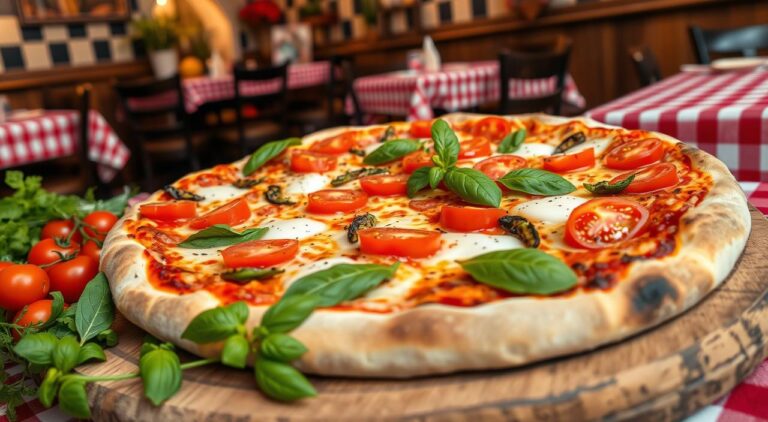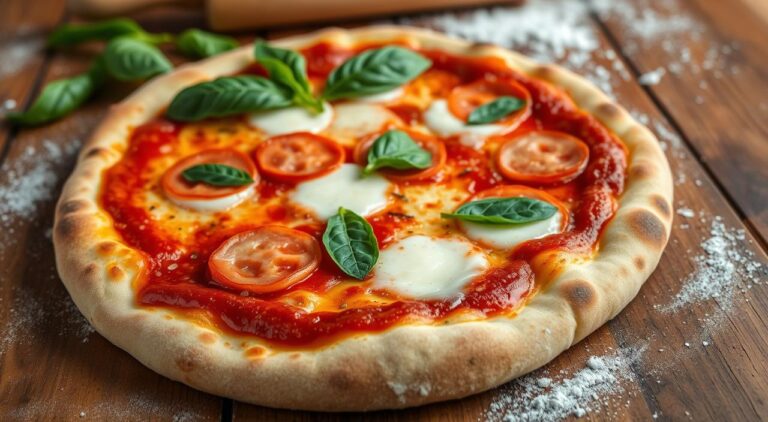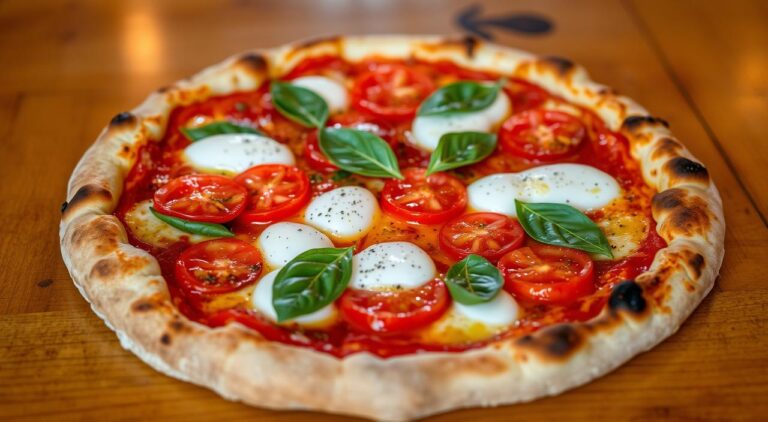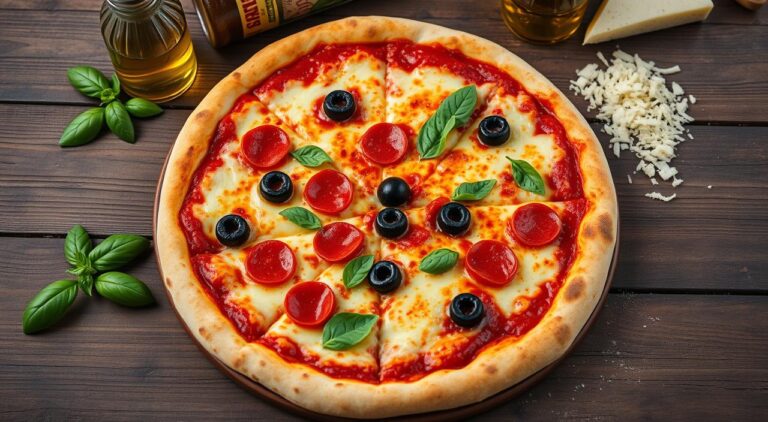Pappardelle is a favorite among food lovers around the world. This wide, ribbon-like egg pasta comes from Tuscany, Italy. It’s a key part of Italian cooking. Its unique texture and ability to hold sauces make it a favorite among pasta fans.
Key Takeaways
- Pappardelle is a traditional Italian egg pasta with a wide, ribbon-like shape.
- It originates from the Tuscany region and is a beloved staple in Italian cuisine.
- Pappardelle’s distinctive texture and versatility make it an excellent canvas for various sauces and preparations.
- The pasta’s rich history and cultural significance contribute to its enduring popularity.
- Pappardelle’s nutritional benefits, such as its durum wheat content, add to its appeal as a healthy and satisfying pasta choice.
Pappardelle Pasta: An Introduction
Pappardelle pasta is a classic from Italy, deeply rooted in Tuscany’s culinary traditions. Its wide, flat shape has won the hearts of pasta lovers around the world. It shows off Tuscany’s culinary skills. From its simple beginnings to its unique features, pappardelle pasta stands as a symbol of Italian cuisine’s lasting impact.
Origins and Significance
The name “pappardelle” comes from the Italian verb “pappare,” meaning “to gobble up.” This name shows how satisfying the pasta is, loved by many in Tuscany over the years. It started in Tuscany’s hills and vineyards, becoming a staple in local meals for centuries.
Defining Characteristics
Pappardelle is known for its wide, flat, and ribbon-like shape. This shape helps it hold onto rich sauces well, making every bite a perfect mix of texture and flavor. Its large surface is perfect for showing off the colors and designs of the pasta-making process.

“Pappardelle pasta is a true embodiment of the rustic, yet refined, essence of Tuscany’s culinary heritage.”
Traditional Ingredients and Preparation
Pappardelle pasta is a classic Italian dish loved for its simple yet tasty ingredients. It’s made with a mix of semolina flour and eggs. These ingredients create a dough that’s both firm and tender.
Semolina Flour and Egg Dough
The key to pappardelle pasta is the semolina flour from durum wheat. It gives the pasta a unique texture and a slightly nutty taste. Adding fresh eggs makes the pasta rich and golden, and helps hold everything together.
Making pappardelle pasta is a tradition that goes back a long time. The dough is kneaded and rested to develop the gluten and blend the flavors. After that, it’s rolled out and cut into wide strips, making the signature pappardelle shape.
“The secret to the perfect pappardelle lies in the quality of the ingredients and the care taken in the preparation.”
This careful preparation makes every bite of pappardelle pasta a celebration of Italy’s rich food culture.
Variations and Regional Specialties
Pappardelle pasta, the wide noodles, is mainly from Tuscan cuisine. But, it’s also found in many parts of Italy. Each region adds its own twist, making pappardelle unique.
These regional takes show how versatile pappardelle is. You’ll find it with meat sauces in Emilia-Romagna and seafood in Liguria. This pasta can take on many flavors.
In the north, pappardelle might be with game sauces. In the south, it’s often with tomato ragùs. These dishes reflect the local tastes and ingredients.
Exploring pappardelle alla lepre (hare ragù) in Tuscany or pappardelle ai funghi (mushroom pappardelle) in the Veneto is exciting. This pasta is a blank canvas for local flavors.
“Pappardelle is like a blank slate, allowing the flavors and textures of its surrounding region to shine through.”
Pappardelle pasta started in Tuscany but has spread across Italy. Its adaptability has created many regional specialties. These dishes celebrate the diversity of traditional Italian pasta traditions.
Pappardelle Pasta: The Perfect Canvas
Pappardelle is a wide, ribbon-like pasta. It’s great for many sauces and flavors. Its big surface lets the flavors shine, making it a favorite among pasta lovers.
Classic Sauces and Pairings
Traditional Italian sauces like ragù, creamy mushroom sauce, and simple tomato sauces go well with pappardelle. The wide pasta wraps around the flavors, making meals satisfying.
Modern Twists and Fusion Dishes
Recently, chefs have gotten creative with pappardelle pasta. They mix global tastes and new ingredients. This has led to exciting pappardelle dishes. From Asian-inspired to Mediterranean, the options are endless.
“Pappardelle’s wide shape and sturdy texture make it the perfect canvas for a variety of sauces, from classic Italian favorites to bold, globally-inspired creations.”
If you like traditional classic sauces or want to try fusion dishes, pappardelle pasta is great. It’s a tasty way to explore new flavors.
Al Dente Perfection: Cooking Tips
Getting the perfect al dente texture is key when cooking pappardelle pasta. This classic Italian pasta is famous for its unique bite and chewiness. It makes every dish more interesting. To make sure your pappardelle pasta is the best it can be, you need to follow specific cooking steps.
The secret to al dente pappardelle is how you cook it. Begin with a big pot of salted boiling water. This lets the pasta cook evenly. Watch the time closely, as pappardelle can quickly go from perfect to overcooked.
- Bring a large pot of salted water to a rolling boil.
- Gently add the pappardelle pasta and stir immediately to prevent sticking.
- Cook the pasta for 8-10 minutes, or until it reaches the desired al dente texture.
- Drain the pasta, reserving a small amount of the cooking water.
- Toss the pappardelle with your desired sauce, adding a splash of the reserved cooking water to create a silky, emulsified texture.
Learning how to cook al dente pappardelle can make any meal better. The right bite of these pasta ribbons can turn a simple dish into something special.
“The secret to perfectly al dente pappardelle is all in the cooking technique. With a little practice, you’ll be serving up pasta perfection in no time.”
Tuscany Cuisine: Pappardelle’s Birthplace
Pappardelle pasta comes from the heart of Tuscany, Italy. The area’s rich farming and focus on local ingredients have shaped pappardelle over the years. It’s not just food; it’s a symbol of Tuscan culture. Pappardelle shows the region’s pride in its long-standing pasta-making traditions and how it unites families and communities.
Cultural Significance
In Tuscany, making and sharing pappardelle is a big deal. It’s linked to special events and family get-togethers. Here, it’s the star of meals that warm the heart and spark conversations. Making pappardelle by hand, a tradition passed down through generations, shows the region’s commitment to its traditional Italian pasta roots.
Pappardelle’s importance in Tuscany goes beyond just food. It pairs perfectly with hearty sauces like the famous wild boar ragù. This shows the deep connection between Tuscany’s cuisine and its natural surroundings. This bond between tradition and land has made pappardelle a key part of Tuscan food culture, symbolizing the region’s culinary identity.
“Pappardelle is more than just a pasta in Tuscany; it’s a culinary tradition that brings people together and celebrates the region’s rich agricultural heritage.”
Durum Wheat Pasta: Nutritional Benefits
Not all pasta is the same. Pappardelle, a classic Italian dish, is known for its great nutritional value. It’s made from semolina flour, which comes from durum wheat. This grain is full of health benefits.
Durum wheat is packed with complex carbs, giving you steady energy. It also has more protein than other wheat types. This makes it great for people who are active or want a balanced diet.
This pasta is full of important vitamins and minerals too. It’s a good source of B vitamins, iron, and selenium. These nutrients help with energy, immune health, and brain function.
Pappardelle from durum wheat pasta and semolina flour is tasty and healthy. Adding it to your meals is an easy way to get more nutrients and support your health.
“Durum wheat pasta is a nutritious and satisfying choice for those seeking a wholesome pasta experience.”
Pasta Ribbons: Versatile and Elegant
The wide, ribbon-like shape of pappardelle pasta makes it perfect for elegant dishes. Chefs and home cooks love to arrange the pasta ribbons on the plate. They use creative twists and swirls for a beautiful look.
This way of plating not only makes the dish look great but also adds to the dining experience. It shows off the versatility and elegance of pappardelle pasta. Whether it’s a classic dish or something new, the wide noodles are a canvas for culinary art. They make the presentation captivating and enjoyable.
Presentation and Plating Techniques
Chefs have many ways to make pappardelle pasta look amazing on the plate. Some top methods include:
- Swirling the pasta into elegant circular patterns
- Arranging the pasta ribbons in a striking linear or zigzag formation
- Layering the noodles to create a visually interesting texture
- Incorporating fresh herbs, edible flowers, or other garnishes to enhance the presentation
These plating techniques make the dish look better and improve the dining experience. They invite guests to enjoy the pasta ribbons with their eyes before tasting them.
| Plating Technique | Description | Best for |
|---|---|---|
| Swirling | Arranging the pasta ribbons in a circular pattern to create a sense of movement and elegance | Classic Italian pappardelle pasta dishes |
| Linear/Zigzag | Positioning the pasta ribbons in a straight or zig-zag line to showcase the shape and texture | Fusion and contemporary pappardelle pasta preparations |
| Layering | Stacking the pasta ribbons to create depth and visual interest on the plate | Hearty, chunky pappardelle pasta dishes with robust sauces |
By using these presentation and plating techniques, chefs and home cooks can make dining special. They show off the true beauty and versatility of pappardelle pasta.
“The beauty of pappardelle pasta lies not only in its delicious flavor but in the way it can be artfully presented on the plate. It’s a canvas for culinary creativity that never fails to impress.”
Traditional Italian Pasta: A Culinary Journey
Pappardelle pasta is a key part of the wide range of traditional Italian pasta types. Each type has its own story, regional twists, and importance in Italian food. Exploring pappardelle and other famous Italian pasta dishes lets food lovers dive into Italy’s rich food culture. It connects them to the country’s traditions and the love behind its dishes.
From pappardelle in Tuscany to thin capellini from the north, each pasta shape has its own story. It reflects the region it comes from, how it’s made, and the special tastes developed over time. These traditional Italian pasta dishes show off Italy’s varied cultural identities. They are tied to local pride, family traditions, and Italy’s rich farming history.
“Pasta is not just food, it’s a way of life in Italy.”
Exploring pappardelle pasta and other famous Italian pasta types reveals a world deeply rooted in tradition yet always changing. Chefs and home cooks add their own twist to these classics. Whether you enjoy a traditional Bolognese or a modern fusion dish, the journey through Italian pasta is an amazing way to experience the country’s rich food culture.
Start your own food adventure with traditional Italian pasta. It will take you from Tuscany’s hills to Naples’ busy streets. Every bite adds a new layer of taste, history, and the spirit that makes Italian food so loved worldwide.
Conclusion
Pappardelle pasta comes from the rich food traditions of Tuscany. It’s a wide, ribbon-like egg pasta loved by food lovers around the world. Its delicious taste and versatility make it a favorite.
This pasta is easy to make and can be paired with many sauces. It shows how traditional Italian pasta remains popular. Pappardelle pasta is a symbol of Italy’s lasting food culture.
The special features of pappardelle pasta make it stand out. Its wide shape and egg-based dough give it a unique texture and flavor. It’s great with traditional Tuscan sauces or in new dishes.
Home cooks and chefs love to use this egg pasta to create new recipes. It’s a key ingredient in many dishes.
The lasting charm of wide noodles like pappardelle lies in its ability to take us to Italy’s heart. It also lets us be creative in the kitchen. We can enjoy the rich tastes and lasting appeal of pappardelle pasta.










